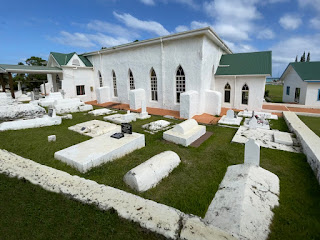Air Rarotonga has been operating day trips to the idyllic Aitutaki atoll for more than a decade. The tour kicks off with an airport transfer at 7:00am, followed by a quick 40-minute flight 260 kms north across the South Pacific. Once on the ground, you’re taken on an hour-long tour of the main island in an open-sided tour truck, before boarding a double-hull catamaran. The remainder of the day is then spent cruising from one palm-clad islet to the next along the eastern rim of Aitutaki’s 50 square kilometre lagoon.
Our airport transfer pulled up outside the resort right on schedule. However, our flight was running 15 minutes late giving us plenty of time to enjoy the antics of a flock of chickens wandering through the open-air departure hall. I can honestly say Rarotonga is the first, and only, airport I’ve visited that offers a live chicken show.
Our flight landed shortly before 9:00am. As promised, the weather on Aitutaki was almost perfect. Just the odd passing cloud, with shirt sleeve temperatures. Sadly, the trade winds followed us from Rarotonga. Thankfully, our tour guides did a superb job of finding sheltered locations throughout the day so the unrelenting wind never spoilt our experience.
According to Wikipedia, the first known European contact in Aitutaki was with Captain Bligh and the crew of HMS Bounty. They arrived at the island on 11 April 1789, a week before the infamous mutiny. Today, almost 40,000 people visit the island every year making tourism the largest contributor to the local economy.
Shortly before 10:30am, our tour group boarded a twin-hull catamaran, called Titi Ai Tonga, for a leisurely 5.5 hour tour of the lagoon. We made four stops during day. The first of these took us to Akaiami Motu. In the 1950s this islet’s sheltered western shore was used for a two-hour refueling stop by TEAL (Tasman Empire Airways Limited) flying boats on the famous Coral Route. These operations ceased in 1960. Today, the only remnant of this golden era is a rather degraded purpose-built coral jetty which our catamaran used as a temporary wave break.
While the Coral Route brought Aitutaki global recognition, its seaplane port isn’t the island’s oldest airport. During the Second World War, New Zealand and American forces actually built two airstrips on the main island. They were part of a chain of airfields established to keep supply routes open as the Japanese advanced across the Pacific. As a result, with support from the locals, Cook Island’s first airport was duly completed on 14 November 1942.
We then relocated to a third island to enjoy a popular snorkeling spot. Garry spent 15-20 minutes exploring the coral reef. However, I found the choppy and windy conditions a bit too hair-raising and gave up after 5 minutes.
The remainder of our lagoon tour was spent on the shores of Tapuaetai (One Foot Island), a small islet in the south-east of the lagoon. This Instagram-perfect location is considered the Cook Island’s premier attraction. It offers exceptional views of the lagoon and features frequently in the nation’s tourism advertising. Garry and went swimming in its aquamarine shoals, being careful to avoid an endless cavalcade of sea cucumbers and the occasional zebrafish.
Our day tour ended with a final stop at the Boatshed Bar where we enjoyed a leisurely Mojito in the shade. This cosy venue is located by the beach, a few hundred metres beyond the southern end of the airport runway. Shortly after 5:15pm we boarded our return flight for a bumpy, but otherwise uneventful, trip back to Rarotonga.
Garry and I decided to finish the day with a local tradition. We asked our airport transfer driver to drop us off at Charlie’s, a popular beachside establishment. This bar, about 1.2kms from our resort, is renowned for its enormous burgers and live music. We ultimately spent a couple of hours here, sheltering from the howling wind, entertained by an island band, a Hulu dancer, and a bucket of cold beers. By the time we’d walked home, I was well and truly ready for bed.

























No comments:
Post a Comment